Effects of COVID-19 related social media use on well-being
Tobias Dienlin
1tobias.dienlin@univie.ac.at
Abstract
In times of crisis such as the COVID-19 pandemic, citizens need to stay informed about recent political events. To this end, people increasingly use social media. However, because social media are particularly engaging, many find it hard to disconnect, especially during times of crisis. In this preregistered study, I investigate whether using social media for COVID-19 related reasons affects psychological well-being. Using data from the Austrian Corona Panel Project consisting of 3,485 participants from 34 waves, this research question was analyzed using random effects within between models, controlling for several stable and varying confounders. The results showed that COVID-19 related social media use did not meaningfully reduce well-being. Other factors such as health, income, exercise, or internal locus of control showed larger and meaningful effects.Introduction
Amidst the COVID-19 pandemic, staying informed became paramount, prompting heavy reliance on social media for updates, with use being at an all time high1. The phenomenon of “doomscrolling” emerged as individuals struggled to disengage from COVID-19-related news2,3, sparking concerns about its impact on mental health4. While initial research began exploring this question5–7, the impact of COVID-19 related social media use on well-being remains largely unknown. This study aims to assess the effects of different social media usage patterns on individual well-being using a comprehensive longitudinal dataset spanning 34 waves, offering insights into within-person causal relationships.
Understanding Well-being and Media Use
This study investigates how different facets of subjective well-being are affected by different types and different channels of communication8. Building on the typology of subjective well-being—defined as “referring to the various types of subjective evaluations of one’s life, including both cognitive evaluations and affective feelings”9—three different well-being facets are analyzed: life satisfaction, positive affect, and negative affect.
Social media is a broad term, encompassing subdimensions such as social networking sites (e.g., Facebook or Instagram), instant messengers (e.g., WhatsApp or Signal), or interactive video-platforms (e.g., YouTube or TikTok)10. Effects of social media depend on how they are used: while purposeful, active, social use is generally related to positive outcomes, passive, non-purposeful and asocial use is related to negative outcomes11,12. However, note that these general distinctions have been challenged recently13,14. In this study, I hence distinguish three types of use and five popular channels. The types of use include posting (active use), reading (passive use), and liking and sharing (low-threshold active use) COVID-19 related content. The five channels to be investigated are Facebook, Twitter, Instagram, WhatsApp, and YouTube, which at the time ranked among the most popular social media services in Austria.
This study aims to provide a nuanced analysis of how a specific type of social media use influences various well-being outcomes. A general measure of time spent on social media would be insufficient to address how engagement with COVID-19-related content affects users. Conversely, using overly specific measures might be less broadly relevant or insightful. For example, demonstrating that receiving uplifting messages boosts social support or that encountering hate speech causes distress might represent limited insights. That said, ultimately, the specificity of a measure is not inherently right or wrong but reflects different approaches to answering different questions. With this study, we can now compare effects across various platforms, shedding light on whether their impacts differed. Moreover, it allows us to determine whether certain effects are unique to specific behaviors on these platforms. Together, these findings offer unprecedented nuanced insights into how COVID-19-related social media activity influenced well-being during the pandemic.
Smallest Effect Size of Interest
Exploring the hypothesis entails establishing the criteria for discerning a ‘trivial effect size.’ To achieve this, it is necessary to define the smallest effect size of interest (SESOI)39. In this context, a trivial effect should fall below the threshold set by the SESOI (detailed below). Determining what constitutes a minimally intriguing, nontrivial effect is a matter with normative implications, making it challenging to arrive at a definitive, singular consensus. I propose the following SESOI as a suitable reference point for this study:
SESOI: If a heavy user of COVID-19 related social media content suddenly stops using social media altogether, this should have a noticeable impact on their overall well-being.
Put concretely, in this study COVID-19 related social media use was measured on a 5-point scale, ranging from 1 = never to 5 = several times a day. Thus, a change of four units in social media use (e.g., a complete stop) should correspond to a noticeable change in well-being. According to Norman and colleagues40, people can reliably notice seven levels of change in satisfaction with health. So if satisfaction is measured on a 7-point scale, a four unit change in social media use should result in a one unit change in life satisfaction. Life satisfaction was measured on an 11-point scale, and affect on a 5-point scale. Transposed to this scaling, the SESOI for life satisfaction is b = ±.30, and for positive and negative affect b = ±.15 (see online supplementary material).
Method
Sample
The data come from the Austrian Corona Panel Project41, which is a large-scale standalone panel study, consisting of 34 waves. The study was conducted between March 2020 and February 2023. Between March 2020 and July 2020, the intervals between waves were weekly, until May 2022 (wave 32) monthly, and afterward after 5 months. Each wave consists of at least 1,500 respondents. Panel mortality (on average ca. 5 percent per wave) was compensated through a continuous re-acquisition of new participants (on average ca. 80 new respondents per wave). The sample size was N = 3,641, with overall 123,794 observations.
Achieved via quota sampling, the sample matched the Austrian population in terms of age, gender, region/state, municipality size, and educational level. In order to participate in the study, the respondents needed to be Austrian residents and had to be at least 14 years of age. All respondents needed to have access to the internet (via computer or mobile devices such as smartphones or tablets). The average age was 40 years, 49 percent were male, 14 percent had a University degree, and 5 percent were currently unemployed.
The study was performed in accordance with the local guidelines at University of Vienna. Ethical review and approval was not required for the study in accordance with the local legislation and institutional requirements. The participants provided their written informed consent to participate in this study. The study complies with the Declaration of Helsinki (2023), aside from the requirement to preregister human subjects research.
Data Analysis
The hypothesis is analyzed using the interval testing approach42. To illustrate, let us consider the case of life satisfaction [SESOI: ±.30]. Here, the null-region lies between -.30 and +.30. If the confidence interval falls completely outside of the null-region (e.g., b = -.40, [95% CI: -.45, -.35]), the hypothesis is rejected and the existence of a meaningful negative effect is supported. For an illustration, see Figure @ref(fig:sesoi).
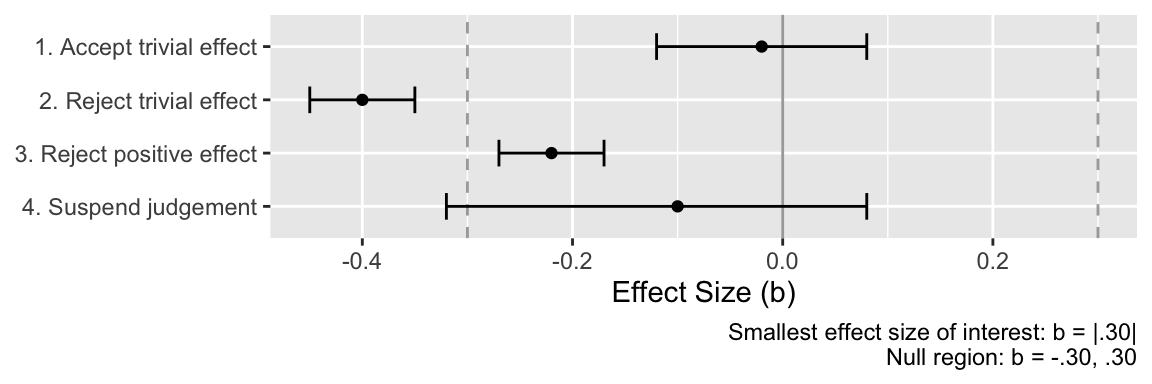
Using confidence intervals to test a null region. In this study, a trivial effect of social media use on life satisfaction is defined as ranging from b = -.30 to b = .30. Figure adapted from Dienes (2014).
Causality
Analyzing causal effects within non-experimental designs requires adopting an internal perspective, focusing on within-person effects43. This entails evaluating how alterations in an individual’s media consumption directly impact changes in their own well-being. Consequently, this study exclusively investigates within-person effects.
An essential strategy for isolating the genuine impact of variables is to control for confounding factors that influence both media use and well-being44. In the context of within-person analysis, this necessitates accounting for time-varying confounders45. However, a cautious balance must be maintained by not controlling for variables that mediate the relationship44, as their inclusion could distort the assessment of the causal effect. This study therefore incorporated several control variables (see below), which have demonstrated connections with both social media use and well-being and are likely not mediators46.
Establishing causality necessitates determining a plausible temporal interval45. For instance, fluctuations in positive and negative affect call for shorter intervals, while the more enduring nature of life satisfaction implies longer intervals47. In this study, I examine the linkage between changes in social media use and changes in affect within the same week. Specifically, I investigate if heightened COVID-19-related social media use during a week corresponds with enhanced or diminished affect during that same week. I consider a longer interval for life satisfaction, examining whether increased COVID-19-related social media use over the course of a week influences one’s life satisfaction at the week’s end. Supplementary analyses extend this investigation to observe how media use might affect well-being one or four months later.
Statistical model
The hypothesis was analyzed using random effect within-between models (REWB)48. Altogether three models were run, one for each dependent variable. The data were hierarchical, and responses were separately nested in participants and waves (i.e., participants and waves were implemented as random effects). Nesting in participants accounts for the within-person design. Nesting in waves controls for general exogenous developments, such as general decreases in well-being in the population, for example due to lockdown measures. Thus, there was no need additionally to control for specific phases or measures of the lockdown. Predictors were modeled as fixed effects. They included social media communication types and channels, separated into within and between-person factors, as well as stable and varying covariates. Between-person predictors (which, measuring relations, are not of particular interest in this study, but are reported online) represent how the mean of one respondent differs from the mean of all the other respondents. The within-person predictors represent how much a person at one specific wave differs from their own mean. All predictors were included simultaneously in each of the three models. No collinearity of predictors was observed.
The factorial validity of the scales were tested with confirmatory factor analyses (CFA). Because Mardia’s test showed that the assumption of multivariate normality was violated, I used the more robust Satorra-Bentler scaled and mean-adjusted test statistic (MLM) as estimator. Mean scores were used for positive and negative affect. Although imputation has inherent drawbacks, we followed recent recommendations to impute missing data on larger scales49. Missing responses were imputed using multiple imputation with predictive mean matching (five iterations, 20 data-sets), including categorical variables. All variables were imputed except the social media use measures, as they were not collected on each wave. All variables included in the analyses presented here were used to impute missing data. For the main analyses, results were pooled across all thirty data-sets.
To contextualize the results, I conducted additional exploratory analyses (see online materials). I reran the analyses (a) with additional not-preregistered covariates such as trust in media or government, (b) without covariates, (c) with single imputation, and (d) without imputation.
Measures
Well-being
Life satisfaction was measured with the item “All things considered, how satisfied are you with your life as a whole nowadays?”, which comes from the European Social Survey. The response options ranged from 0 (extremely dissatisfied) to 10 (extremely satisfied).
To capture positive affect, respondents were asked how often in the last week they felt (a) calm and relaxed, (b) happy, and (c) full of energy50. The response options were 1 (never), 2 (on some days), 3 (several times per week), 4 (almost every day), and 5 (daily). The scale showed good factorial fit, \(\chi^2\)(66) = 69.42, p = .363, CFI = 1.00, RMSEA < .01, 90% CI [< .01, .02], SRMR = .01. Reliability was high, \(\omega\) = .85.
For negative affect, respondents were asked how often in the last week they felt (a) lonely, (b) aggravated, (c) so depressed, that nothing could lift you up, (d) very nervous, (e) anxious, and (h) glum and sad50. The response options were 1 (never), 2 (on some days), 3 (several times per week), 4 (almost every day), and 5 (daily). The scale showed good factorial fit, \(\chi^2\)(471) = 4012.14, p < .001, CFI = .98, RMSEA = .07, 90% CI [.07, .08], SRMR = .03. Reliability was high, \(\omega\) = .91.
All three variables were measured on each wave.
Control variables
The effects of COVID-19 related social media use were controlled for the following stable variables: gender (female, male, diverse), age, education (ten options), Austria country of birth (yes/no), Austria parents’ country of birth (no parent, one parent, both parents), and household size. I also controlled for the following varying covariates: five items on current living conditions, including self-reported physical health, whether participants contracted COVID-19 since the last wave, current household income, working in home-office, and overall work hours; five items measuring outdoor activities such as exercise or meeting friends; and two more psychological measures including locus of control and disposition to take risks.
Results
Descriptive Analyses
Looking at the variables from a descriptive perspective, aligned with set-point theory we can see that the level of all well-being measures were comparatively stable during data collection (see Figure @ref(fig:fig-descriptives)). COVID-19 related social media use, however, showed changes. Reading, sharing and liking COVID-19 related content decreased substantially (almost one scale point from 3 to 2). Posting about COVID-19 related content stayed the same. Using Facebook and WhatsApp for COVID-19 related content decreased. Instagram, YouTube, and Twitter stayed the same. The general initial decrease could be explained by the fact that the collection of data began at the end of March 2020, hence approximately three months after the pandemic’s onset. After an initial uptick, COVID-19 related social media use might have already been declining at the time.
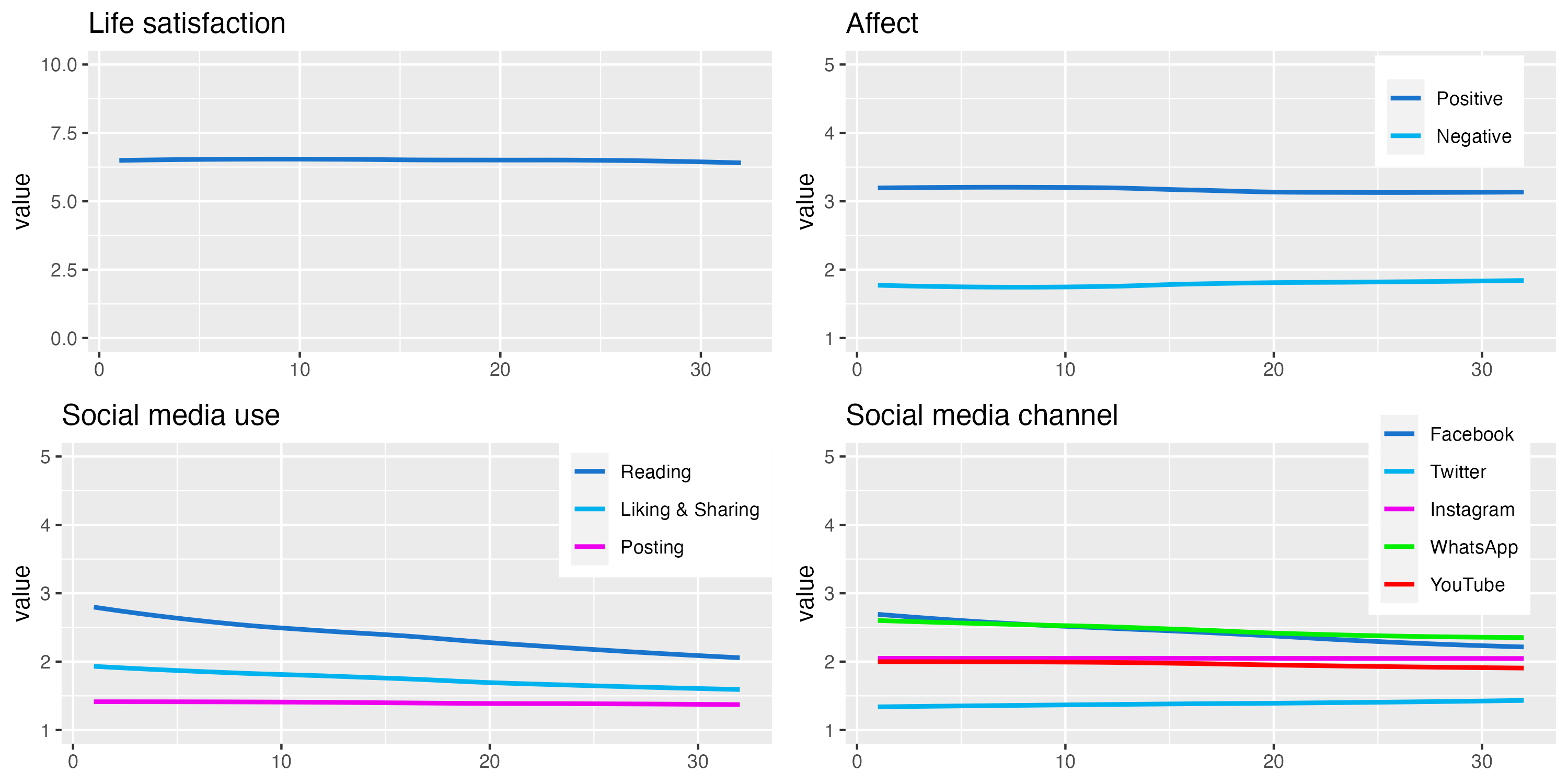
Well-being and media use across the 34 waves. Note. Values obtained from mixed effect models, with participants and waves as grouping factors and without additional predictors.
Using the average values across all waves, which provides a stable picture of the general relations, I next looked at the correlations between social media use and well-being (see Figure @ref(fig:fig-correlations)). In general, people who spent more time engaging with COVID-19 related content on social media reported reduced well-being. Users who spent more time reading, liking and sharing, and posting COVID-19 related content were less satisfied with their lives. They also showed slightly less positive affect. This overall negative picture was even more pronounced for negative affect. People who engaged more with COVID-19 related content, including all types and channels of communication, reported substantially higher levels of negative affect. For example, people who were more likely to post COVID-19 content had much higher levels of negative affect (r = .61). Note that these results represent between-person correlations, not causal within-person effects.
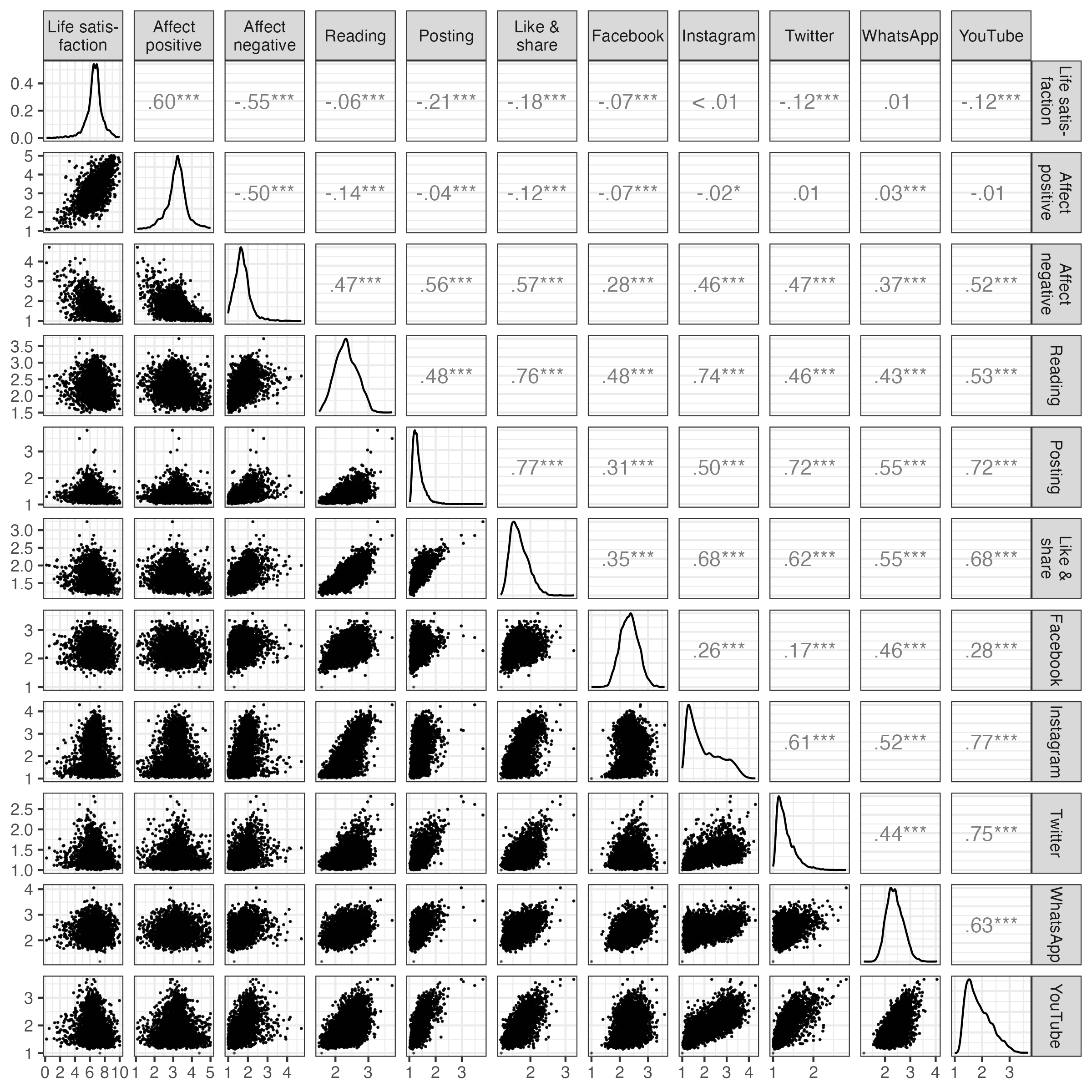
Descriptives of the main variables, capturing well-being and social media use with their average values across all waves. Upper triangle: correlation coefficients; diagonal: density plots; lower triangle: scatter plots.
Preregistered Analyses
Regarding the effects of different communication types (i.e., reading, sharing, of posting about COVID-19 related content), all within-person effects fell completely within the a-priori defined null region (see Figure @ref(fig:fig-within)). For example, respondents who used social media more frequently than usual to like or share COVID-19 related content did not show a simultaneous change in life satisfaction (b = -0.02 [95% CI -0.06, 0.01]). As a result, the hypothesis of trivial effects was supported for all COVID-19 related types of social media communication.
However, several effects stood out, as statistically they were significantly different from zero. Users who read more COVID-19 related content than usual reported slightly reduced levels of positive affect (b = -0.03 [95% CI -0.05, -0.02]). Users who liked and shared more COVID-19 related content than usual also experienced slightly more negative affect than usual (b = 0.05 [95% CI 0.04, 0.07]). Posting COVID-19 related content affected all types of well-being. Users who wrote more COVID-19 related posts than usual also reported slightly less life satisfaction than usual (b = -0.04 [95% CI -0.08, -0.01]) and slightly more negative affect than usual (b = 0.05 [95% CI 0.04, 0.07]). Interestingly, however, users who wrote more COVID-19 related posts than usual also experienced slightly higher levels of positive affect than usual (b = 0.02 [95% CI 0.01, 0.04]).
Regarding the COVID-19 related use of social media channels (i.e., Facebook, Instagram, WhatsApp, YouTube, and Twitter) the results were comparable (see Figure @ref(fig:fig-within)). Changes in the frequency of using different social media channels to attain information regarding COVID-19 were unrelated to meaningful changes in well-being. For example, respondents who used Facebook more frequently than usual to learn about COVID-19 did not show a simultaneous change in life satisfaction (b -0.01 [95% CI -0.04, 0.02]). In sum, the hypothesis of trivial effects was supported also for the COVID-19 related use of important social media channels.
That said, two effects differed statistically from zero. Respondents who used Twitter more frequently than usual to attain COVID-19 related content reported slightly higher levels of negative affect than usual (b = 0.02 [95% CI 0.01, 0.04]). Likewise, respondents who used YouTube more frequently than usual for COVID-19 related issues reported slightly higher levels of negative affect than usual (b = 0.01 [95% CI < 0.01, 0.02]). However, both effects were still completely inside of the null region, hence likely not large enough to be considered meaningful.
For an overview of all within-person effects, see Figure @ref(fig:fig-within).
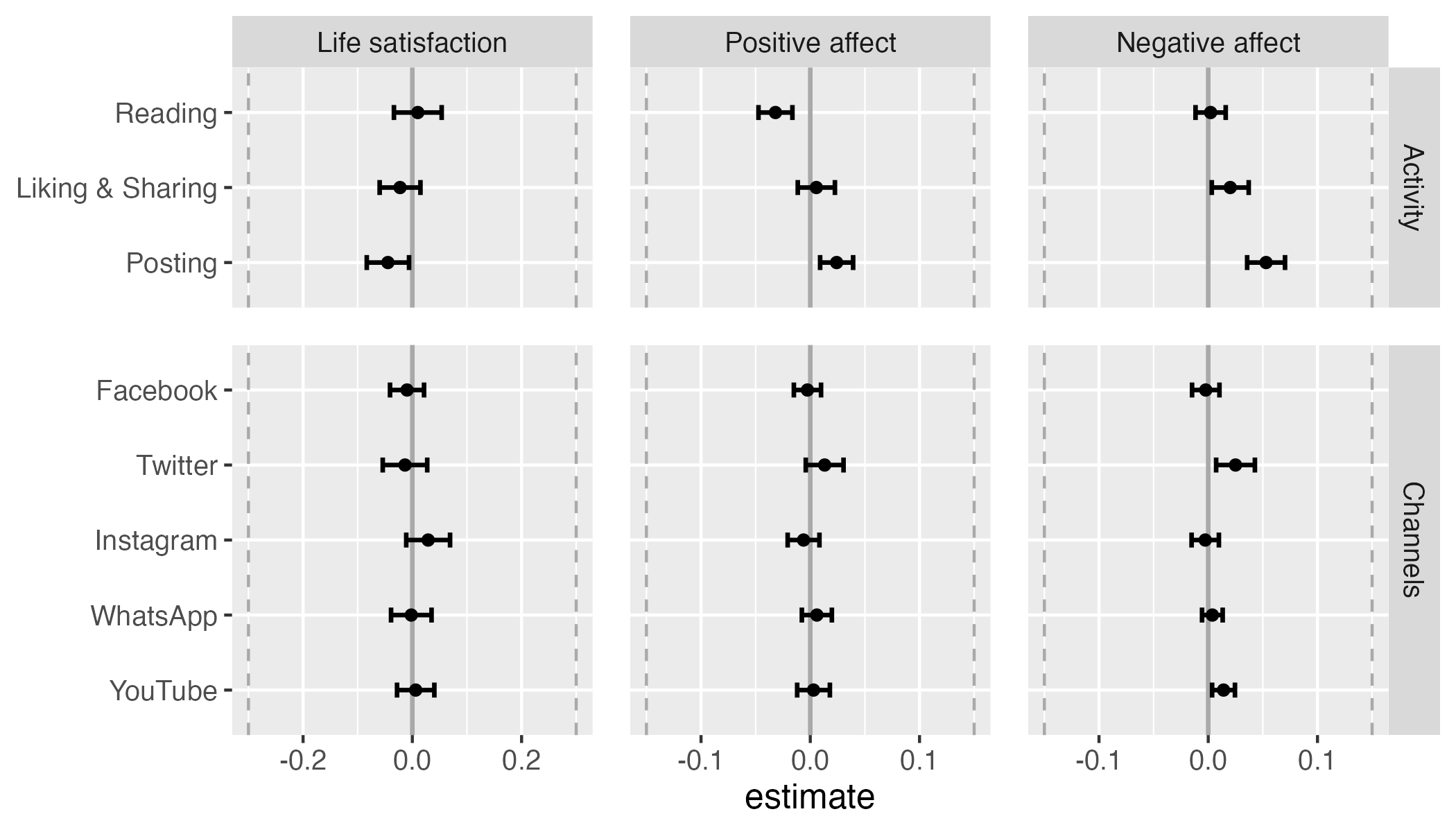
Unstandardized within-person effects of COVID-19 related social media use on well-being. Note. The SESOI was b = |0.30| for life satisfaction and b = |0.15| for affect. Hence, all of the reported effects are not considered large enough to be meaningful.
Exploratory Analyses
To contextualize the results reported above and to see if the study included any meaningful effects at all, I also looked at the effect sizes of the covariates. I report the results of the standardized scales, which allows for a better comparison across the differently scaled variables. As a SESOI, we can build on Cohen’s convention that small effects begin at r = |.10|.
The results showed that several effects crossed or fell completely outside of the SESOI, and can hence be considered meaningful. For example, if physical health decreased, this had a meaningful detrimental impact on life satisfaction (\(\beta\) = .19 [95% CI .18, .20]), positive affect (\(\beta\) = .18 [95% CI .17, .19]), and negative affect (\(\beta\) = -.19 [95% CI -.20, -.18]). Spending more time outside to exercise meaningfully increased positive affect (\(\beta\) = .12 [95% CI .11, .14]). The strongest aspect affecting well-being was internal locus of control. If people felt more in control of their lives, this strongly increased both life satisfaction (\(\beta\) = .33 [95% CI .31, .35]) and positive affect (\(\beta\) = .28 [95% CI .27, .30]), while decreasing negative affect (\(\beta\) = -.29 [95% CI -.31, -.27]). For an overview, see Figure @ref(fig:fig-control).
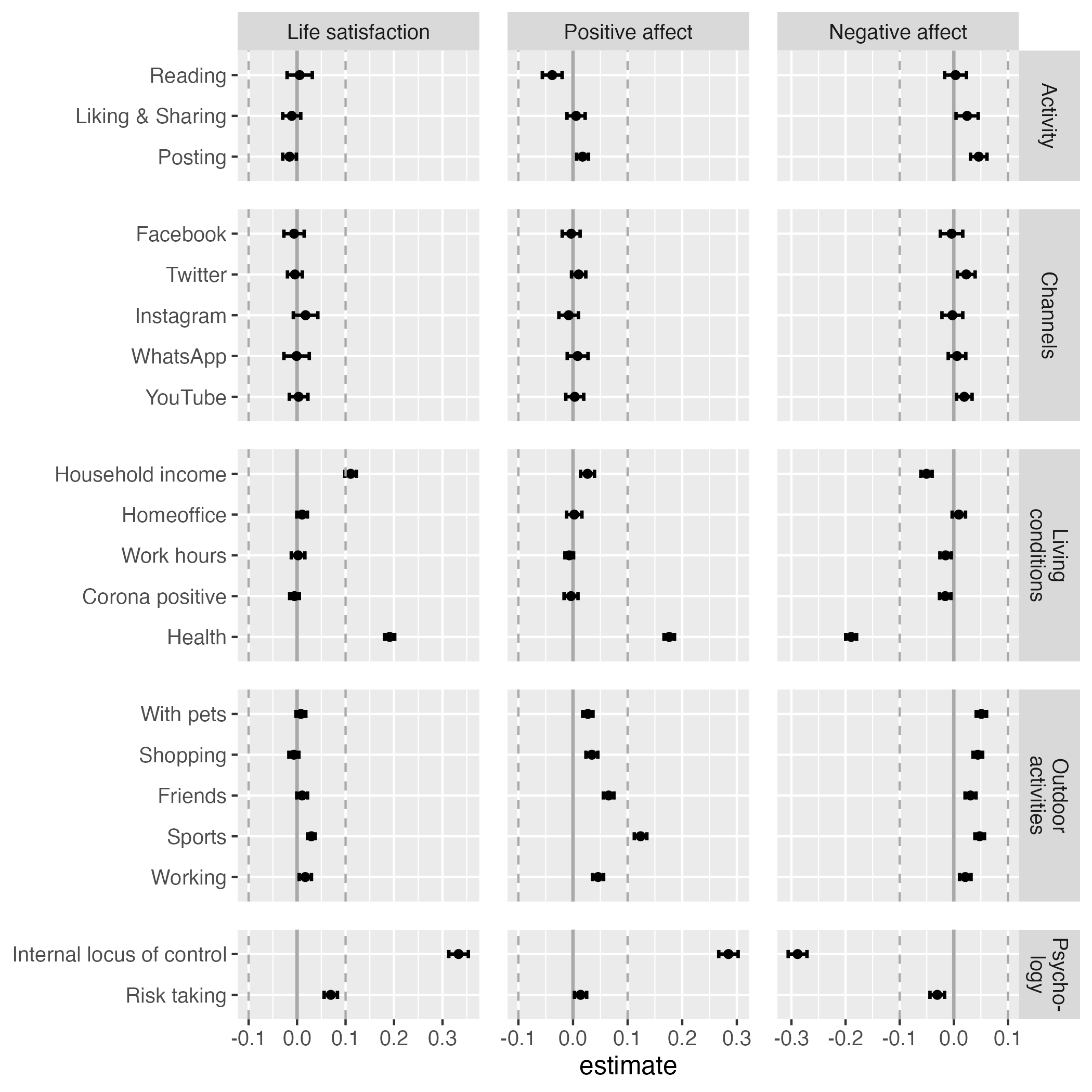
Results of main variables together with covariates to provide context. All variables standardized. SESOI: beta = |.10|
Because life satisfaction is more stable than affect, the effects of communication might materialize some time later. I hence also tested the effects across the longer intervals of one month and four months. Results showed that all effects disappeared. No effect remained significant, implying that at least in this case in this case effects take place on a shorter interval.
Finally, as suggested by the differential susceptibility of media effects model, media effects can depend on dispositional factors, developmental stages, or cultural norms16, such as gender and age52. I hence reran the analyses, differentiating effects for boys and girls and for age cohorts. The results showed that effects did not differ across genders. The effects also did not depend on age. However, one effect stood out and was significant. Compared to the middle age category Generation X, results showed that if users from Generation Z posted more COVID-19 content than usual this lead to significantly more negative affect (\(\beta\) = .04 [95% CI .01, .06]).
Discussion
This study, based on a representative panel study spanning 34 waves within the Austrian population, investigated the impact of COVID-19-related social media usage on well-being. The between-person correlations revealed that increased engagement with COVID-19 content on social media was associated with decreased well-being. For instance, individuals consuming more COVID-19-related content reported slightly lower life satisfaction, somewhat reduced positive affect, and notably elevated negative affect compared to others.
To explore if these between-person correlations stem from causal within-person effects, it was examined whether within-person changes in media consumption corresponded to within-person changes in well-being. As expected and aligned with the literature, increased consumption of COVID-19 content did not significantly decrease well-being at a meaningful level. While several statistically significant effects emerged, their magnitudes were notably small. For instance, reading more COVID-19 posts than usual slightly decreased positive affect. Liking and sharing more COVID-19 content than usual were associated with slightly higher negative affect. Posting more COVID-19 content reduced life satisfaction slightly while elevating both positive and negative affect. The effects, although statistically significant, fell within a predefined range considered too small to be meaningful.
Further analysis demonstrated that factors such as health and physical activity, which would be expected to have substantial impacts on well-being, indeed showed significant influences. Additionally, extended assessments covering one and four months did not yield meaningful effects. In summary, the influence of COVID-19-related social media activity on well-being was not substantial. This counters popular concerns over social media use during crises causing substantial well-being risks.
That said, there is no consensus among scholars as to when effects become practically relevant and meaningful. If we adopt a more liberal and cautious perspective, the study indicates a tendency for COVID-19-related social media usage to impact well-being negatively. Notably several statistically significant negative effects were observed, contrasting with a single positive effect. Hence, although effects were overall very small, the trend was for effects to be negative.
Specifically, reading COVID-19 related content slightly reduced positive affect, while liking, sharing, and posting increased negative affect slightly. Publishing COVID-19-related posts increased both negative and positive affect slightly, while it reduced life satisfaction. This suggests that posting generates stronger reactions, both positive and negative. It seems the often extreme, negative, or aggressive tone of COVID-19 discussions on social media53 could have stronger impacts on more active authors. Posting COVID-19 content was more negative for Generation Z, potentially reflecting broader negative effects of social media on this generation. Together, this finding is aligned with recent work challenging the assumption that active use is inherently beneficial and passive use detrimental14. Notably, communication channels exhibited differences. Twitter and YouTube appeared more negative, whereas Instagram, WhatsApp, and Facebook were neutral. This finding is aligned with the general observation that content on Twitter is often more negative54, thereby impairing the well-being of their users27. In contrast, Instagram, which typically features more positive content, shows no evidence of such negative effects. These results align with prior research highlighting that social media usage is rather associated with elevated negative affect but not reduced life satisfaction8, implying that effects tend to be more short-lived. The study suggests that varying communication types and channels warrant separate analyses, as patterns differed across communication types and channels.
In conclusion, the study aligns with theoretical models and past research. It supports the notion of social media effects being small or even negligible and contingent on communication type and channel8,16. Effects not being strongly negative also help explain why people spent so much time engaging with COVID-19 content on social media20,22.
Several limitations exist. While the study’s focus on within-person effects enhances causal understanding, challenges exist related to additional relevant confounding exogenous variables not included here44, correct definition of the SESOI39, and exact measurement of media use55. As noted above, different operationalizations of COVID-19 related social media use might lead to different results. For example, the measures of social media use did not include interpersonal communication about COVID-19 related content, which might result in more positive outcomes11. Similarly, we asked participants only about the frequency of their own posts related to COVID-19, without inquiring how often they commented on other posts or replied to other users. Different types of COVID-19-related content—for instance, inspiring self-help posts versus aggressive discussions—are likely to have varying effects on well-being. Future research could explore these differences further through detailed content-level analyses. During a social media session, users encounter diverse content while often engaging in specific types of interactions, which can elicit varying sequential emotional responses. Examining how well-being fluctuates throughout a session could yield valuable insights. While this study did not find meaningful within-person effects of social media use on well-being, between person analyses revealed strong negative correlations. Alternative causal processes not explored in this paper might explain these correlations. The study’s results are applicable primarily to Western societies and may not hold true in different cultural contexts.
The study’s findings conclude that COVID-19-related social media activity minimally affects well-being, with other factors such as health and physical activity playing more substantial roles. In light of these minimal effects, concerns over COVID-19-related social media engagement on well-being could not be substantiated.
Research Transparency Statement
Conflicts of interest: The author declares no conflicts of interest. Funding: This research did not receive external funding. Artificial intelligence: Chat GPT was used for language polishing. Computational reproducibility: All analyses and the manuscript itself are completely reproducible (https://tdienlin.github.io/Austrian_Corona_Panel/).
Preregistration: The hypotheses, the sample, the measures, the analyses, and the inference criteria (SESOI, p-value) were preregistered on the Open Science Framework (https://osf.io/87b24/?view_only=b2289b6fec214fa88ee75a18d45c18f3). Because in this study data from an already existing data set was analyzed, the preregistration was done prior to accessing the data. In some cases, it was impossible to execute the analyses as originally planned, for example because some properties of the variables only became apparent when seeing the actual data. All changes are reported online (https://tdienlin.github.io/Austrian_Corona_Panel/preregistration_changes.html). Materials: All study materials are publicly available (https://tdienlin.github.io/Austrian_Corona_Panel/items_english.html). Data: All primary data are publicly available (https://doi.org/10.11587/28KQNS). Analysis scripts: All analysis scripts are publicly available (https://tdienlin.github.io/Austrian_Corona_Panel/).
References
Acknowledgements
I would like to thank Niklas Johannes for providing valuable feedback on this manuscript. Open access funding provided by University of Vienna.
Social Media Effects on Well-Being
Current literature overviews suggest that more active social media users report on average lower well-being8. However, for most well-being outcomes, such as life satisfaction, general well-being, or loneliness, the effects are small8. In addition, these results are based mostly on correlational research, and a recent meta study based on experimental studies did not find significant causal effects15. These small or even non-existent findings can be explained with the differential susceptibility of media effects model16, which states that there is substantial variation of media effects for individual users. For example, in one study it was estimated that roughly one quarter of all users experienced negative effects, another quarter positive effects, while for the rest the effects were neutral17.
Why are the effects of social media use on well-being small on average, especially given that several scholars theorize strong negative effects18,19? Two prominent media effect theories argue implicitly against strong average negative effects. First, according to mood management theory20, using media can affect people’s moods. After some time, users implicitly learn which media help them balance their mood and affect according to their own situational needs20. Those media that eventually become part of one’s media repertoire hence, on average, tend to be beneficial for users to regulate their mood21. In conclusion, if a certain medium is used frequently, mood-management theory argues that it is likely not detrimental for well-being.
Second, while mood management theory considers media use mainly driven by implicit learning experiences, uses and gratifications theory upholds that the process is more explicit and rational22. Users select those media that they expect to have a desired effect, for example on mood, knowledge, or entertainment. And social media, in general, offer several beneficial effects, explaining their ubiquitous use. They help find relevant information, maintain and foster relationships, express one’s personality, and entertain oneself23.
Third, and closely related, media use affords both both positive and negative mechanisms, which differently impact well-being outcomes. These include factors like social comparison, inspiration, social connectedness, social support, displacement of in-person activities, information management, information overload, misinformation, reputation building, romantic connection, coping resources, or emotional contagion12,23–26. Given these differential mechanisms, strong one-sided effects appear less likely than nuanced and moderate effects.
On the contrary, there are also studies finding negative effects of social media use on well-being27,28. Users do not always achieve the gratifications they seek, with obtained gratifications often differing from expected gratifications29. Likewise, people might not always use social media because they receive gratifications, but rather because doing so has become an implicit habit30. Specific negative mechanisms, such as displacement of more meaningful activities, might also outweigh the positive paths. Despite these arguments, the extensive time people spend consuming COVID-19-related content on social media suggests, based on mood management theory, uses and gratifications theory, and various differential mechanisms, that the average effects on well-being are likely to be more moderate and neutral.